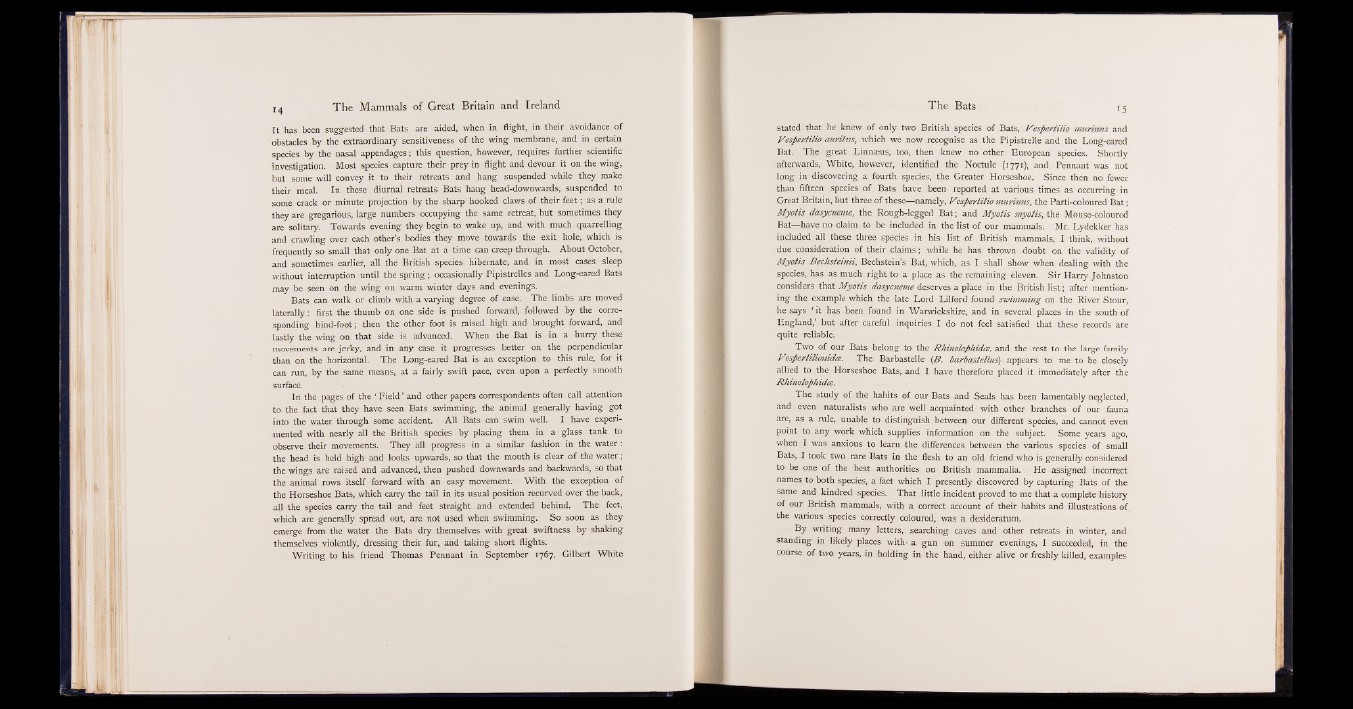
It has been suggested that Bats are aided, when in flight, in their avoidance of
obstacles by the extraordinary sensitiveness of the wing membrane, and in certain
species by the nasal appendages; this question, however, requires further scientific
investigation. Most species capture their prey in flight and devour it on the wing,
but some will convey it to their retreats and hang suspended while they make
their meal. In these diurnal retreats Bats hang head-downwards, suspended to
some crack or minute projection by the sharp hooked claws of their feet; as a rule
they are gregarious, large numbers occupying the same retreat, but sometimes they
are solitary. Towards evening they begin to wake up, and with much quarrelling
and crawling over each other’s bodies they move towards the exit hole, which is
frequently so small that only one Bat at a time can creep through. About October,
and sometimes earlier, all the British species hibernate, and in most cases sleep
without interruption until the spring; occasionally Pipistrelles and Long-eared Bats
may be seen on the wing on warm winter days and evenings.
Bats can walk or climb with a varying degree of ease. The limbs are moved
laterally: first the thumb on one side is pushed forward, followed by the corresponding
hind-foot; then the other foot is raised high and brought forward, and
lastly the wing on that side is advanced. When the Bat is in a hurry these
movements are jerky, and in any case it progresses better on the perpendicular
than on the horizontal. The Long-eared Bat is an exception to this rule, for it
can run, by the same means, at a fairly swift pace, even upon a perfectly smooth
surface.
In the pages of the ‘ Field ’ and other papers correspondents often call attention
to the fact that they have seen Bats swimming, the animal generally having got
into the water through some accident. All Bats can swim well. I have experimented
with nearly all the British species by placing them in a glass tank to
observe their movements. They all progress in a similar fashion in the water:
the head is held high and looks upwards, so that the mouth is clear of the water;
the wings are raised and advanced, then pushed downwards and backwards, so that
the animal rows itself forward with an easy movement. With the exception of
the Horseshoe Bats, which carry the tail in its usual position recurved over the back,
all the species carry the tail and feet straight and extended behind. The feet,
which are generally spread out, are not used when swimming. So soon as they
emerge from the water the Bats dry themselves with great swiftness by shaking
themselves violently, dressing their fur, and taking short flights.
Writing to his friend Thomas Pennant in September 1767, Gilbert White
stated that he knew of only two British species of Bats, Vespertilio murinus and
Vespertilio auritus, which we now recognise as the Pipistrelle and the Long-eared
Bat. The great Linnaeus, too, then knew no other European species. Shortly
afterwards, White, however, identified the Noctule (1771), and Pennant was not
long in discovering a fourth species, the Greater Horseshoe. Since then no fewer
than fifteen species of Bats have been reported at various times as occurring in
Great Britain, but three of these— namely, Vzspertilio murinus, the Parti-coloured Bat;
Myotis dasycneme, the Rough-legged Bat; and Myotis myotis, the Mouse-coloured
Bat— have no claim to be included in the list of our mammals. Mr. Lydekker has
included all these three species in his list of British mammals, I think, without
due consideration of their claims; while he has thrown doubt on the validity of
Myotis Bechsteinii, Bechstein’s Bat, which, as I shall show when dealing with the
species, has as much right to a place as the remaining eleven. Sir Harry Johnston
considers that Myotis dasycneme deserves a place in the British list; after mentioning
the example which the late Lord Lilford found swimming on the River Stour,
he says ‘ it has been found in Warwickshire, and in several places in the south of
England,’ but after careful inquiries I do not feel satisfied that these records are
quite reliable.
Two of our Bats belong to the Rhinolophidce, and the rest to the large family
Vzspertihomdce. The Barbastelle (B . barbastellus) appears to me to be closely
allied to the Horseshoe Bats, and I have therefore placed it immediately after the
Rhinolophidce.
The study of the habits of our Bats and Seals has been lamentably neglected,
and even naturalists who are well acquainted with other branches of our fauna
are, as a rule, unable to distinguish between our different species, and cannot even
point to any work which supplies information on the subject. Some years ago,
when I was anxious to learn the differences between the various species of small
Bats, I took two rare Bats in the flesh to an old friend who is generally considered
to be one of the best authorities on British mammalia. He assigned incorrect
names to both species, a fact which I presently discovered by capturing Bats of the
same and kindred species. That little incident proved to me that a complete history
of our British mammals, with a correct account of their habits and illustrations of
the various species correctly coloured, was a desideratum.
By writing many letters, searching caves and other retreats in winter, and
standing in likely places with' a gun on summer evenings, I succeeded, in the
course of two years, in holding in the hand, either alive or. freshly killed, examples